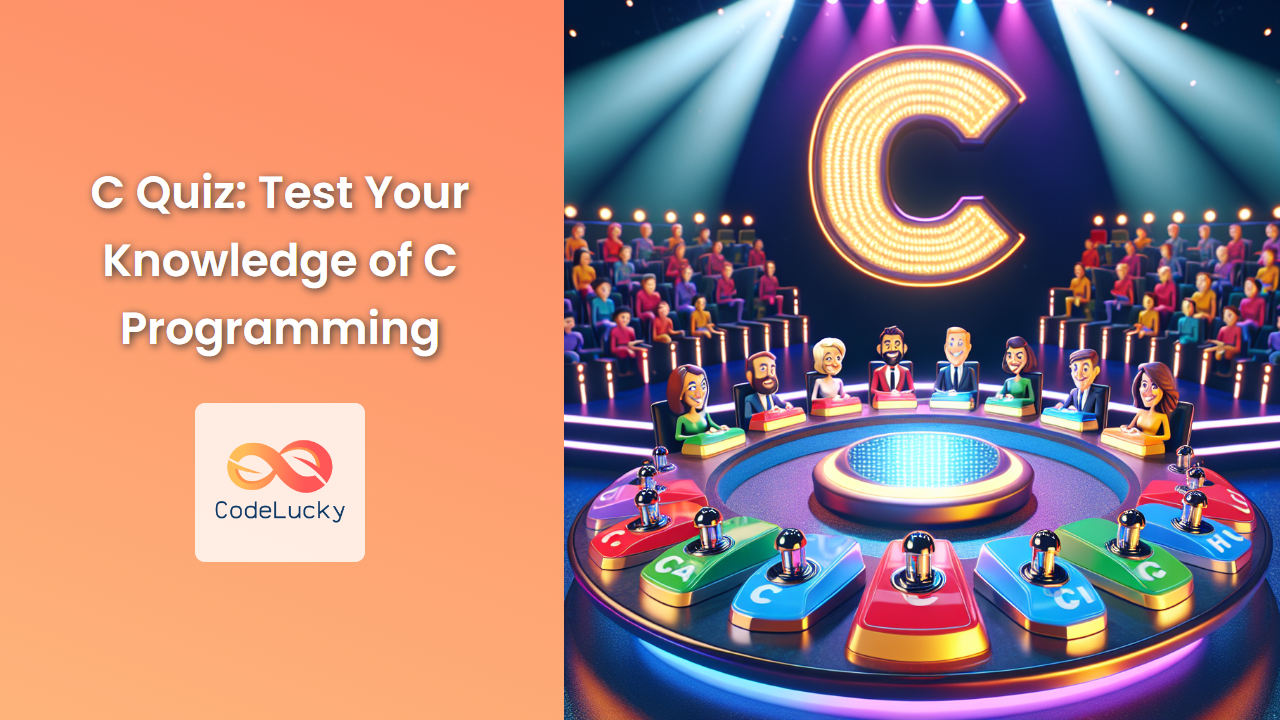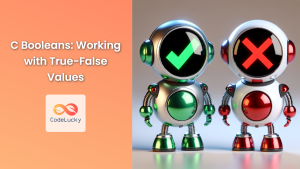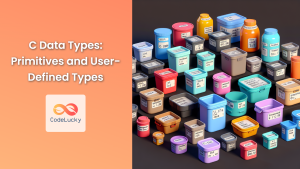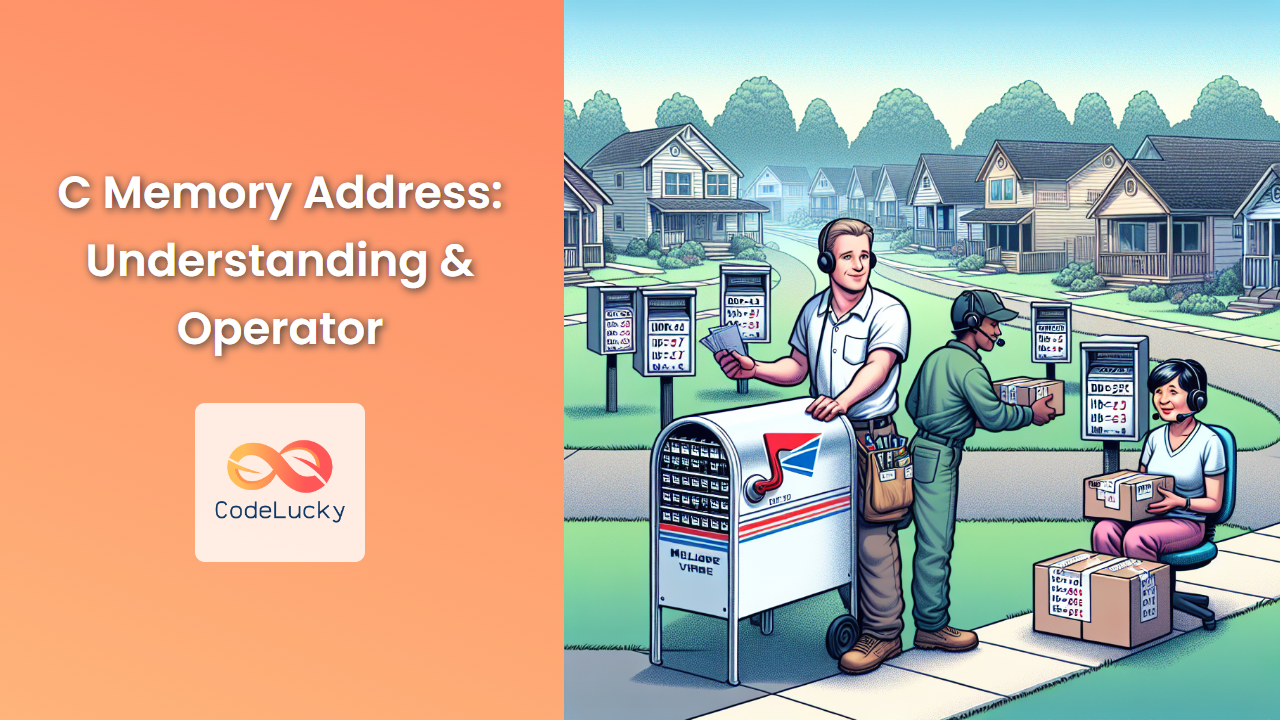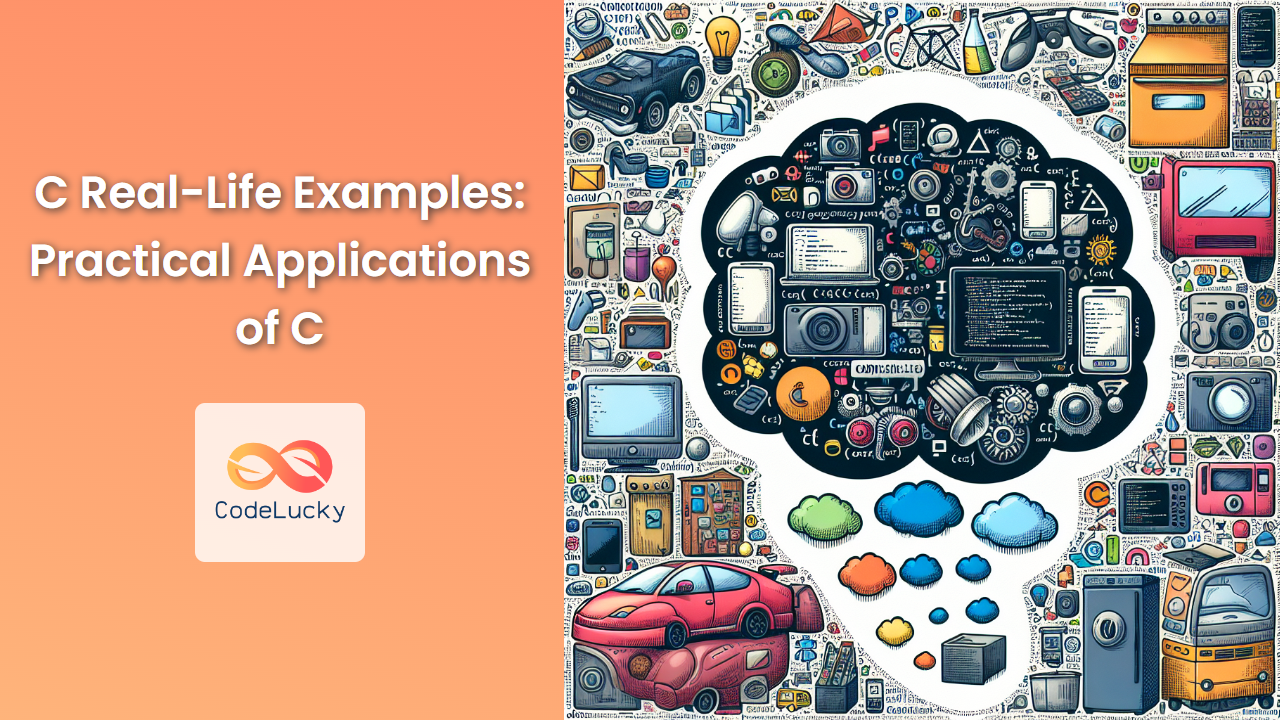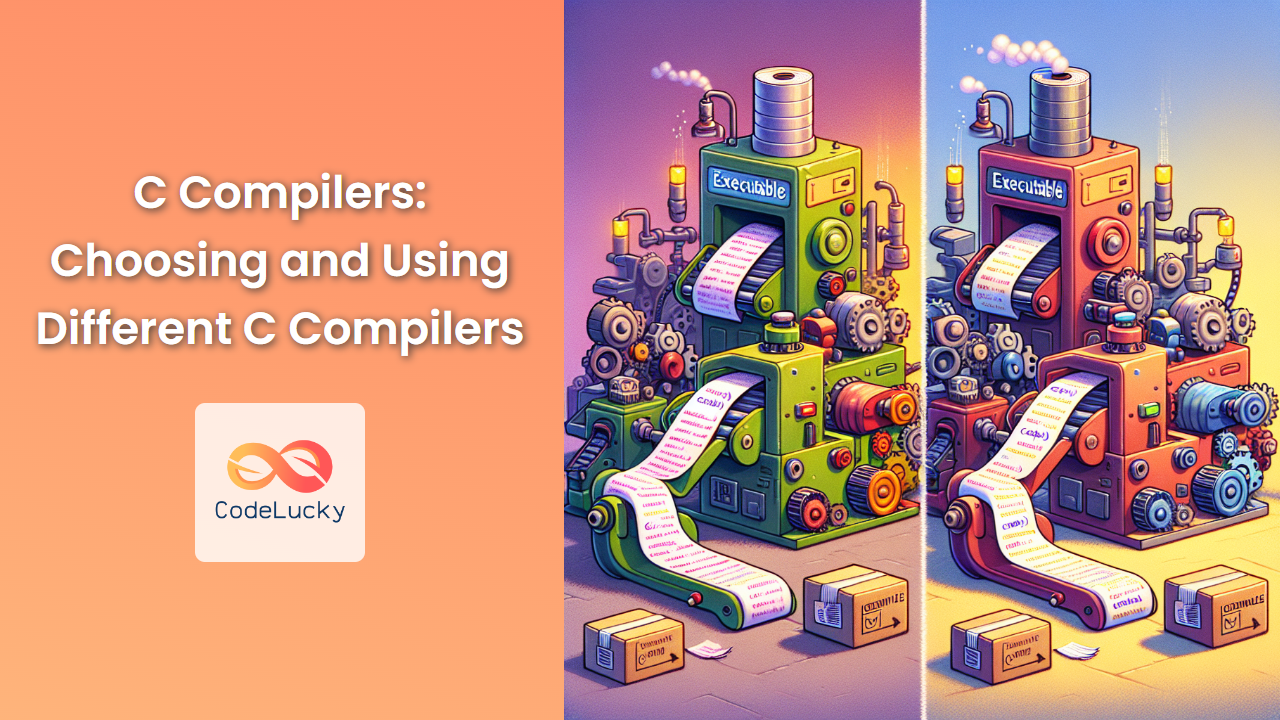Are you ready to put your C programming skills to the test? 🧠💻 Whether you're a seasoned developer or just starting out, this comprehensive quiz will challenge your understanding of C and help you identify areas for improvement. Let's dive in and see how well you know one of the most influential programming languages in history!
Question 1: Variable Declaration
Which of the following is a valid variable declaration in C?
a) int 123variable;
b) float _temperature;
c) char @symbol;
d) double 3.14value;
Answer: b) float _temperature;
Explanation: In C, variable names must start with a letter or underscore, followed by letters, digits, or underscores. Option b is the only valid declaration. Let's break down why the others are incorrect:
- a) Variables cannot start with a number
- c) Special characters like @ are not allowed in variable names
- d) Variables cannot start with a number or contain a decimal point
Here's a valid C program demonstrating correct variable declarations:
#include <stdio.h>
int main() {
int validVariable = 123;
float _temperature = 98.6;
char letter = 'A';
double pi_value = 3.14159;
printf("Valid variables: %d, %.1f, %c, %.5f\n", validVariable, _temperature, letter, pi_value);
return 0;
}
Output:
Valid variables: 123, 98.6, A, 3.14159
Question 2: Operator Precedence
What is the output of the following C code?
#include <stdio.h>
int main() {
int x = 5, y = 3, z = 2;
int result = x + y * z;
printf("Result: %d\n", result);
return 0;
}
a) 16
b) 11
c) 13
d) 10
Answer: b) 11
Explanation: In C, operator precedence determines the order in which operations are performed. Multiplication (*) has higher precedence than addition (+). Therefore, the expression is evaluated as:
- y z = 3 2 = 6
- x + 6 = 5 + 6 = 11
To change the order of operations, we would need to use parentheses. For example:
int result = (x + y) * z; // This would give 16
Understanding operator precedence is crucial for writing correct and efficient C code. 📊
Question 3: Pointer Arithmetic
Consider the following C code:
#include <stdio.h>
int main() {
int arr[] = {10, 20, 30, 40, 50};
int *ptr = arr + 2;
printf("Value: %d\n", *ptr);
ptr++;
printf("Next value: %d\n", *ptr);
return 0;
}
What will be the output?
a) Value: 10
Next value: 20
b) Value: 20
Next value: 30
c) Value: 30
Next value: 40
d) Value: 40
Next value: 50
Answer: c) Value: 30
Next value: 40
Explanation: This question tests your understanding of pointer arithmetic in C. Let's break it down:
arris an integer array with 5 elements.ptris initialized toarr + 2, which means it points to the third element of the array (remember, array indexing starts at 0).- The first
printfstatement outputs the value pointed to byptr, which is 30. ptr++increments the pointer to the next integer in the array.- The second
printfstatement outputs the new value pointed to byptr, which is 40.
Pointer arithmetic is a powerful feature in C, allowing efficient manipulation of arrays and data structures. However, it requires careful handling to avoid buffer overflows and undefined behavior. 🚀
Question 4: Function Prototypes
Which of the following is a correct function prototype in C?
a) void calculateSum(int a, b);
b) int multiplyNumbers(int x, int y, int z);
c) float divideValues(float, float);
d) char getGrade(int score, char);
Answer: c) float divideValues(float, float);
Explanation: Function prototypes in C declare the function's return type, name, and parameter types. Let's analyze each option:
a) Incorrect: Parameter types must be specified for each parameter.
b) Correct syntax, but not the answer we're looking for.
c) Correct: Parameter names can be omitted in prototypes, only types are necessary.
d) Incorrect: Mixing named and unnamed parameters is not allowed in C function prototypes.
Here's a C program demonstrating correct function prototypes and their implementations:
#include <stdio.h>
// Function prototypes
int addNumbers(int, int);
float divideValues(float, float);
char getGrade(int);
int main() {
printf("Sum: %d\n", addNumbers(5, 3));
printf("Division: %.2f\n", divideValues(10.0, 3.0));
printf("Grade: %c\n", getGrade(85));
return 0;
}
// Function implementations
int addNumbers(int a, int b) {
return a + b;
}
float divideValues(float x, float y) {
return x / y;
}
char getGrade(int score) {
if (score >= 90) return 'A';
else if (score >= 80) return 'B';
else if (score >= 70) return 'C';
else if (score >= 60) return 'D';
else return 'F';
}
Output:
Sum: 8
Division: 3.33
Grade: B
Function prototypes are essential for larger C programs, allowing functions to be used before their full definition and enabling better code organization. 📚
Question 5: Preprocessor Directives
Which of the following is NOT a valid preprocessor directive in C?
a) #include
b) #define
c) #ifdef
d) #import
Answer: d) #import
Explanation: Preprocessor directives in C are commands that are processed before the actual compilation begins. They start with a '#' symbol. Let's examine each option:
a) #include: Used to include header files.
b) #define: Used to define macros or constants.
c) #ifdef: Used for conditional compilation.
d) #import: This is not a standard C preprocessor directive. It's used in Objective-C, but not in standard C.
Here's a C program demonstrating the use of valid preprocessor directives:
#include <stdio.h>
#define PI 3.14159
#define SQUARE(x) ((x) * (x))
#ifdef DEBUG
#define LOG(x) printf("Debug: %s\n", x)
#else
#define LOG(x)
#endif
int main() {
printf("Value of PI: %.5f\n", PI);
printf("Square of 5: %d\n", SQUARE(5));
LOG("This message will only appear if DEBUG is defined");
return 0;
}
Output (when DEBUG is not defined):
Value of PI: 3.14159
Square of 5: 25
Preprocessor directives are powerful tools in C for conditional compilation, macro definitions, and including external files. They play a crucial role in making C code more flexible and maintainable. 🛠️
Question 6: Structures and Unions
Consider the following C code:
#include <stdio.h>
struct Point {
int x;
int y;
};
union Data {
int i;
float f;
char str[20];
};
int main() {
struct Point p = {10, 20};
union Data d;
d.i = 10;
d.f = 220.5;
printf("Structure size: %lu\n", sizeof(p));
printf("Union size: %lu\n", sizeof(d));
printf("Union values: %d, %.1f\n", d.i, d.f);
return 0;
}
What will be the output of this program?
a) Structure size: 8
Union size: 24
Union values: 10, 220.5
b) Structure size: 8
Union size: 20
Union values: 1127743488, 220.5
c) Structure size: 4
Union size: 20
Union values: 10, 10.0
d) Structure size: 8
Union size: 20
Union values: 1127743488, 220.5
Answer: d) Structure size: 8
Union size: 20
Union values: 1127743488, 220.5
Explanation: This question tests your understanding of structures and unions in C. Let's break it down:
-
The
struct Pointhas two int members, each typically 4 bytes on most systems, so the total size is 8 bytes. -
The
union Datasize is determined by its largest member. Thechar str[20]is the largest at 20 bytes, so the union size is 20 bytes. -
In the union, all members share the same memory. When we assign 220.5 to
d.f, it overwrites the previous value ofd.i. -
When we print
d.i, we're interpreting the float bit pattern as an integer, resulting in 1127743488. -
The float value 220.5 is correctly printed.
Structures and unions are fundamental concepts in C for creating custom data types. While structures allow you to group related data of different types, unions provide a way to use the same memory location for different types of data. This can be useful for saving memory or interpreting data in multiple ways. 🧩
Question 7: File I/O
Which of the following C functions is used to read a single character from a file?
a) getc()
b) scanf()
c) fscanf()
d) fgets()
Answer: a) getc()
Explanation: The getc() function in C is used to read a single character from a file. Let's examine each option:
a) getc(): Correct. It reads a single character from a specified stream.
b) scanf(): Used for formatted input from stdin, not specifically for file I/O.
c) fscanf(): Used for formatted input from a file, but not limited to a single character.
d) fgets(): Used to read a string from a file, not a single character.
Here's a C program demonstrating file I/O operations, including the use of getc():
#include <stdio.h>
int main() {
FILE *file;
char ch;
int charCount = 0;
// Writing to a file
file = fopen("example.txt", "w");
if (file == NULL) {
printf("Error opening file!\n");
return 1;
}
fprintf(file, "Hello, File I/O!");
fclose(file);
// Reading from the file
file = fopen("example.txt", "r");
if (file == NULL) {
printf("Error opening file!\n");
return 1;
}
printf("File contents:\n");
while ((ch = getc(file)) != EOF) {
putchar(ch);
charCount++;
}
printf("\nTotal characters: %d\n", charCount);
fclose(file);
return 0;
}
Output:
File contents:
Hello, File I/O!
Total characters: 15
This program demonstrates writing to a file using fprintf(), then reading from it character by character using getc(). File I/O is crucial for many C applications, allowing programs to persist data and process large amounts of information efficiently. 📁
Question 8: Memory Allocation
Which function is used to dynamically allocate memory in C?
a) alloc()
b) malloc()
c) realloc()
d) calloc()
Answer: b) malloc()
Explanation: While all options except alloc() are related to dynamic memory allocation in C, malloc() is the primary function used for this purpose. Let's examine each:
a) alloc(): This is not a standard C function.
b) malloc(): Correct. It allocates the specified number of bytes and returns a pointer to the allocated memory.
c) realloc(): Used to resize previously allocated memory.
d) calloc(): Allocates memory for an array of elements and initializes them to zero.
Here's a C program demonstrating the use of dynamic memory allocation:
#include <stdio.h>
#include <stdlib.h>
int main() {
int *arr;
int n = 5;
// Allocate memory for 5 integers
arr = (int*)malloc(n * sizeof(int));
if (arr == NULL) {
printf("Memory allocation failed\n");
return 1;
}
// Initialize the array
for (int i = 0; i < n; i++) {
arr[i] = i * 10;
}
// Print the array
printf("Dynamically allocated array:\n");
for (int i = 0; i < n; i++) {
printf("%d ", arr[i]);
}
printf("\n");
// Resize the array to 7 elements
int *new_arr = (int*)realloc(arr, 7 * sizeof(int));
if (new_arr == NULL) {
printf("Memory reallocation failed\n");
free(arr);
return 1;
}
arr = new_arr;
// Add two more elements
arr[5] = 50;
arr[6] = 60;
// Print the resized array
printf("Resized array:\n");
for (int i = 0; i < 7; i++) {
printf("%d ", arr[i]);
}
printf("\n");
// Free the allocated memory
free(arr);
return 0;
}
Output:
Dynamically allocated array:
0 10 20 30 40
Resized array:
0 10 20 30 40 50 60
This program demonstrates the use of malloc() for initial memory allocation, realloc() for resizing the allocated memory, and free() for deallocating the memory when it's no longer needed. Dynamic memory allocation is essential for creating flexible data structures and managing memory efficiently in C programs. 🧠💾
Question 9: Bitwise Operations
What is the result of the bitwise operation 5 & 3 in C?
a) 8
b) 1
c) 7
d) 2
Answer: b) 1
Explanation: This question tests your understanding of bitwise operations in C. Let's break it down:
- 5 in binary is 0101
- 3 in binary is 0011
- The & operator performs a bitwise AND operation
Performing the operation bit by bit:
0101 (5)
& 0011 (3)
-------
0001 (1)
Therefore, the result is 1.
Here's a C program demonstrating various bitwise operations:
#include <stdio.h>
void printBinary(int n) {
for (int i = 7; i >= 0; i--) {
printf("%d", (n >> i) & 1);
}
printf("\n");
}
int main() {
int a = 5, b = 3;
printf("a = %d (", a);
printBinary(a);
printf(")\n");
printf("b = %d (", b);
printBinary(b);
printf(")\n");
printf("a & b = %d (", a & b);
printBinary(a & b);
printf(")\n");
printf("a | b = %d (", a | b);
printBinary(a | b);
printf(")\n");
printf("a ^ b = %d (", a ^ b);
printBinary(a ^ b);
printf(")\n");
printf("~a = %d (", ~a);
printBinary(~a);
printf(")\n");
printf("a << 1 = %d (", a << 1);
printBinary(a << 1);
printf(")\n");
printf("b >> 1 = %d (", b >> 1);
printBinary(b >> 1);
printf(")\n");
return 0;
}
Output:
a = 5 (00000101)
b = 3 (00000011)
a & b = 1 (00000001)
a | b = 7 (00000111)
a ^ b = 6 (00000110)
~a = -6 (11111010)
a << 1 = 10 (00001010)
b >> 1 = 1 (00000001)
This program demonstrates various bitwise operations in C:
- & (AND): Sets each bit to 1 if both bits are 1
- | (OR): Sets each bit to 1 if at least one of the bits is 1
- ^ (XOR): Sets each bit to 1 if exactly one of the bits is 1
- ~ (NOT): Inverts all the bits
- << (Left Shift): Shifts all bits to the left by the specified number of positions
-
(Right Shift): Shifts all bits to the right by the specified number of positions
Bitwise operations are powerful tools in C, often used for optimizing performance, working with hardware, and implementing various algorithms efficiently. 🔢
Question 10: Enumerations
Consider the following C code:
#include <stdio.h>
enum Days {MON, TUE, WED, THU, FRI, SAT, SUN};
int main() {
enum Days today = WED;
printf("Today is day number: %d\n", today);
return 0;
}
What will be the output of this program?
a) Today is day number: 1
b) Today is day number: 2
c) Today is day number: 3
d) Today is day number: 0
Answer: b) Today is day number: 2
Explanation: This question tests your understanding of enumerations in C. Here's how it works:
- In C, enumerations are a way to define a set of named integer constants.
- By default, the first constant in an enum is assigned the value 0, and each subsequent constant is incremented by 1.
- In this enum, MON is 0, TUE is 1, WED is 2, and so on.
- When we print the value of WED, it outputs 2.
Here's an expanded C program demonstrating more features of enumerations:
#include <stdio.h>
enum Colors {RED = 5, GREEN, BLUE = 10, YELLOW};
enum Months {
JAN = 1, FEB, MAR, APR, MAY, JUN,
JUL, AUG, SEP, OCT, NOV, DEC
};
int main() {
enum Colors favorite_color = BLUE;
enum Months birth_month = SEP;
printf("My favorite color has the value: %d\n", favorite_color);
printf("I was born in month number: %d\n", birth_month);
// Using enums in a switch statement
switch(favorite_color) {
case RED:
printf("Your favorite color is Red\n");
break;
case GREEN:
printf("Your favorite color is Green\n");
break;
case BLUE:
printf("Your favorite color is Blue\n");
break;
case YELLOW:
printf("Your favorite color is Yellow\n");
break;
default:
printf("Unknown color\n");
}
return 0;
}
Output:
My favorite color has the value: 10
I was born in month number: 9
Your favorite color is Blue
This program demonstrates several important aspects of enumerations in C:
- You can assign specific values to enum constants (e.g., RED = 5).
- If you don't specify a value, it takes the value of the previous constant plus one (e.g., GREEN is 6).
- You can mix specified and unspecified values (e.g., YELLOW is 11).
- Enums are often used to make code more readable and maintainable.
- They work well with switch statements, improving code clarity.
Enumerations are a powerful feature in C for creating named constants, making code more readable and less prone to errors. They're particularly useful when you have a set of related constants, such as days of the week, months, or color codes. 🗓️🌈
Conclusion
Congratulations on completing this comprehensive C programming quiz! 🎉 We've covered a wide range of topics, from basic syntax and data types to more advanced concepts like pointer arithmetic, file I/O, and bitwise operations. Here's a quick recap of the areas we've explored:
- Variable declarations and naming conventions
- Operator precedence
- Pointer arithmetic
- Function prototypes
- Preprocessor directives
- Structures and unions
- File I/O operations
- Dynamic memory allocation
- Bitwise operations
- Enumerations
Remember, mastering C programming is an ongoing journey. Each of these topics has depths that can be further explored and applied in various programming scenarios. Keep practicing, experimenting with code, and challenging yourself with new problems to continually improve your C programming skills.
Whether you aced this quiz or found some areas for improvement, the key is to keep learning and coding. C remains a fundamental language in computer science and software development, and a strong foundation in C can benefit you in many areas of programming.
Keep up the great work, and happy coding! 💻🚀
- Question 1: Variable Declaration
- Question 2: Operator Precedence
- Question 3: Pointer Arithmetic
- Question 4: Function Prototypes
- Question 5: Preprocessor Directives
- Question 6: Structures and Unions
- Question 7: File I/O
- Question 8: Memory Allocation
- Question 9: Bitwise Operations
- Question 10: Enumerations
- Conclusion

